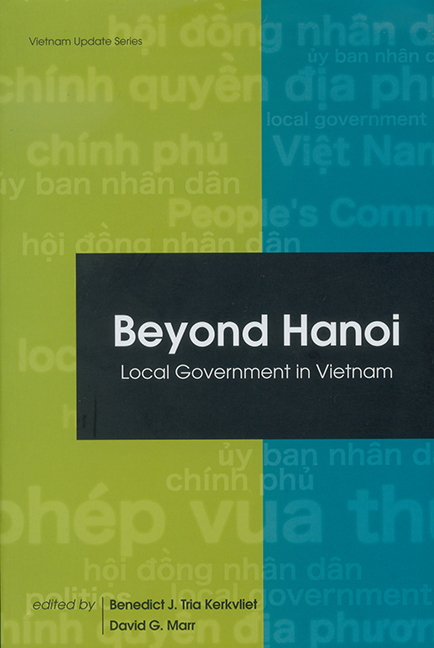Book contents
- Frontmatter
- Contents
- Preface
- Abbreviations
- 1 Surveying Local Government and Authority in Contemporary Vietnam
- 2 A Brief History of Local Government in Vietnam
- 3 Village Government in Pre-colonial and Colonial Vietnam
- 4 Caught in the Middle: Local Cadres in Hai Duong Province
- 5 Winter Crop and Spring Festival: The Contestations of Local Government in a Red River Delta Commune
- 6 Local Politics and Democracy in a Muong Ethnic Community
- 7 Local Government in the Exercise of State Power: the Politics of Land Allocation in Black Thai Villages
- 8 Urban Government: Ward-level Administration in Hanoi
- 9 The Facilitators of Rural Transformation and Development: The Role of Agricultural Extension Officers in Two Districts of Long An Province
- 10 Ho Chi Minh City's Post-1975 Political Elite: Continuity and Change in Background and Belief
- 11 Push, Pull, and Reinforcing: The Channels of FDI Influence on Provincial Governance in Vietnam
- Glossary of Vietnamese Terms
- Index
- About the Contributors
4 - Caught in the Middle: Local Cadres in Hai Duong Province
Published online by Cambridge University Press: 21 October 2015
- Frontmatter
- Contents
- Preface
- Abbreviations
- 1 Surveying Local Government and Authority in Contemporary Vietnam
- 2 A Brief History of Local Government in Vietnam
- 3 Village Government in Pre-colonial and Colonial Vietnam
- 4 Caught in the Middle: Local Cadres in Hai Duong Province
- 5 Winter Crop and Spring Festival: The Contestations of Local Government in a Red River Delta Commune
- 6 Local Politics and Democracy in a Muong Ethnic Community
- 7 Local Government in the Exercise of State Power: the Politics of Land Allocation in Black Thai Villages
- 8 Urban Government: Ward-level Administration in Hanoi
- 9 The Facilitators of Rural Transformation and Development: The Role of Agricultural Extension Officers in Two Districts of Long An Province
- 10 Ho Chi Minh City's Post-1975 Political Elite: Continuity and Change in Background and Belief
- 11 Push, Pull, and Reinforcing: The Channels of FDI Influence on Provincial Governance in Vietnam
- Glossary of Vietnamese Terms
- Index
- About the Contributors
Summary
Introduction
Since the Vietnamese communists carried out the August Revolution of 1945, they have attempted to establish an administrative system from central government through provinces and districts to villages, to gain a firm foothold across the whole country. Such a multi-level structure was particularly important for the construction of socialism and to strengthen the support of the rural population in the wars against France and the United States.
This chapter examines the role of Communist Party government local cadres in Hai Duong province in the Red River delta over three broad periods of Vietnam's recent history: land reform in the 1950s; collectivization from the late 1950s–80s; and decollectivization (from the 1980s) onwards. The term “local cadres” refers to officials within the commune, including members of the People's Councils (Hoi Dong Nhan Dan), the People's Committees (Uy Ban Nhan Dan), party cells (chi bo), agrarian cooperatives (hop tac xa nong nghiep), mass organizations (to chuc quan chung) and heads of villages (truong thon).
The central questions of this study are: how has the Vietnamese Communist Party leadership dealt with problems regarding local cadres in Hai Duong; how well have local cadres fulfilled their duties; and what have relations between commune cadres and residents been like? I argue that there is a big gap between central and local government in the realization of party policy on local cadres. Unlike officials at higher levels, local cadres in Hai Duong have to carry out central government policies while also representing their communities. Having to fulfill these two functions at the same time, cadres are often in conflict with local people.
“Classism” — Local Cadres during the Land Reform of the 1950s
The land reform campaign of the 1950s was the first attempt by the Communist Party to establish local government in the Hai Duong countryside. The initial step towards land reform was to create a local government compatible with the party's objectives.
- Type
- Chapter
- Information
- Beyond HanoiLocal Government in Vietnam, pp. 90 - 109Publisher: ISEAS–Yusof Ishak InstitutePrint publication year: 2004

